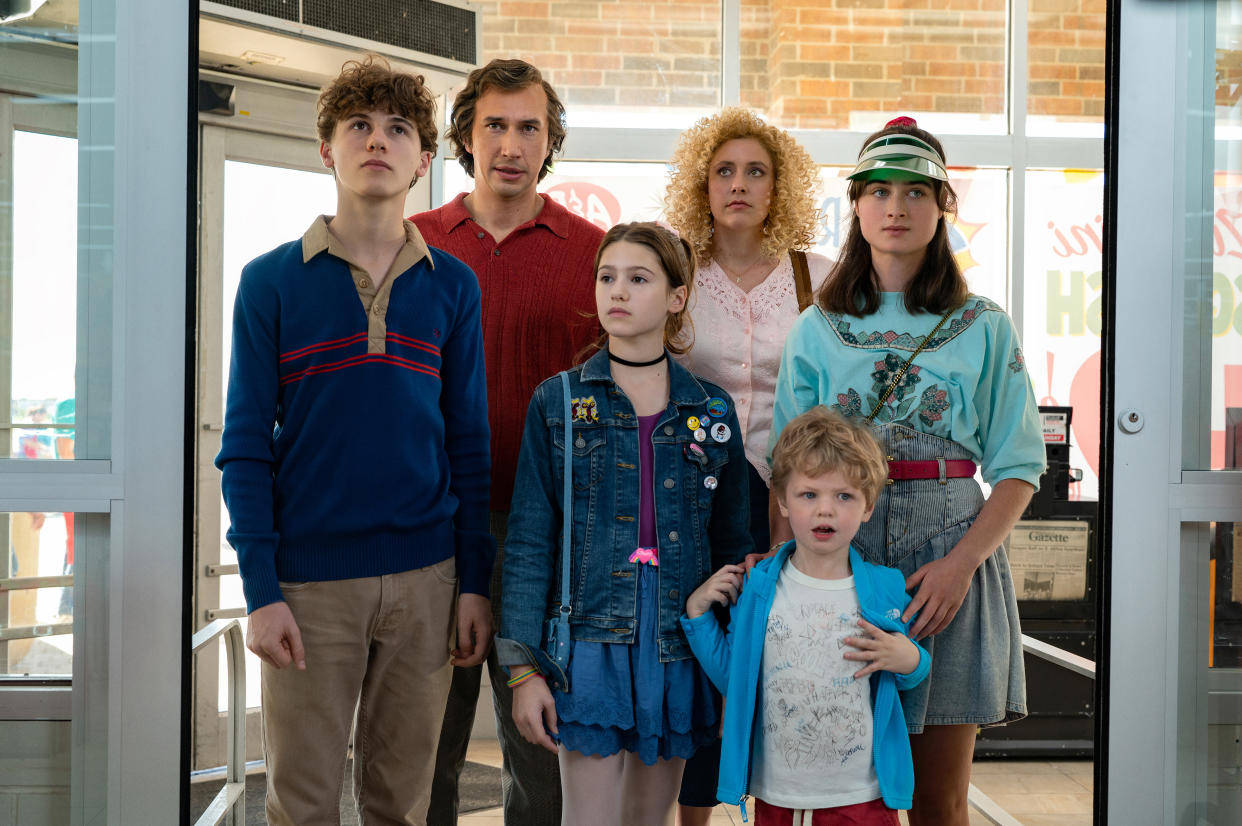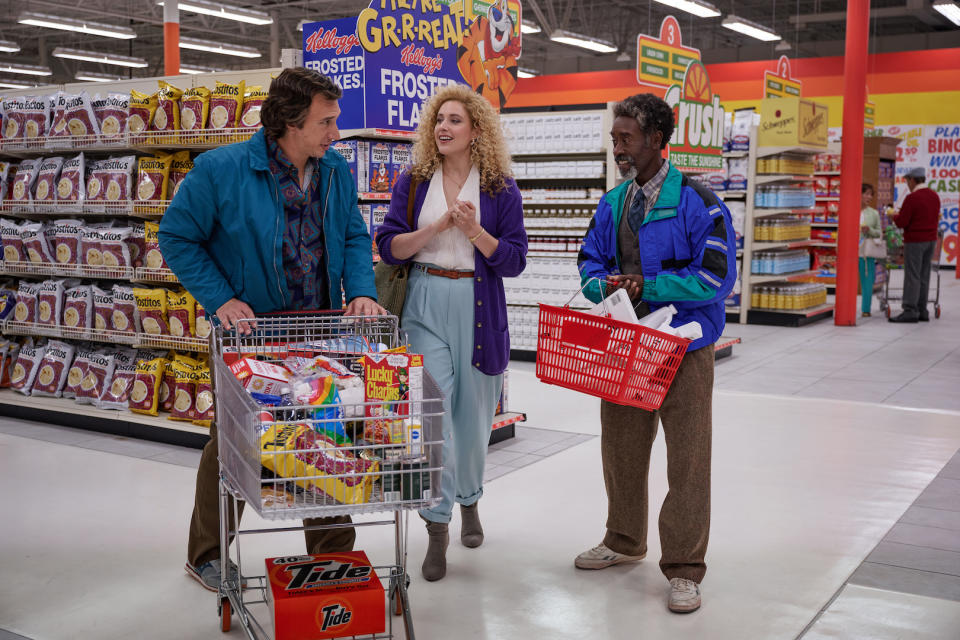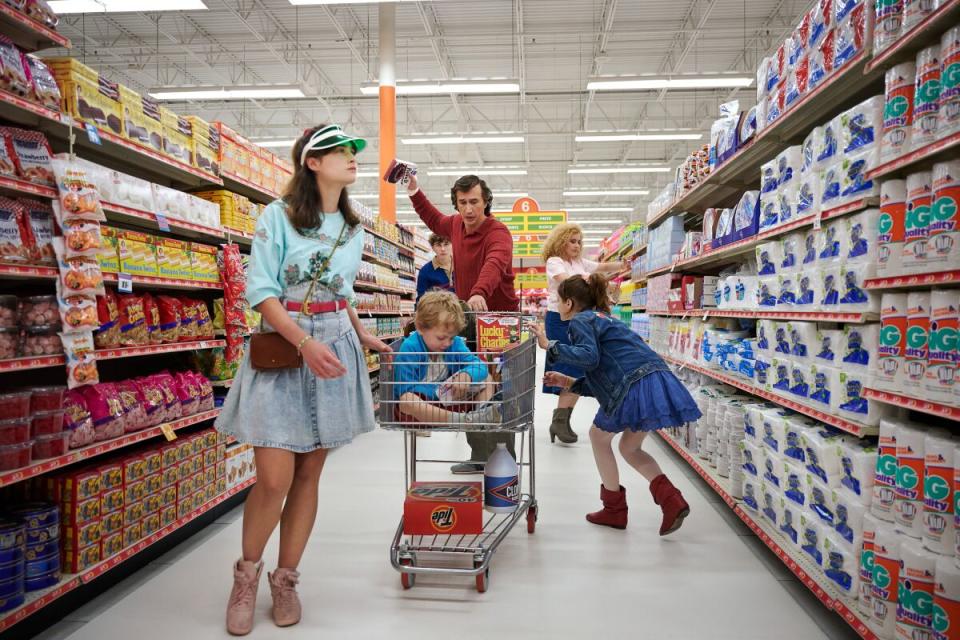Dancing in the Aisles — How ‘White Noise’ Made Its A&P Market So Super

- Oops!Something went wrong.Please try again later.
- Oops!Something went wrong.Please try again later.
- Oops!Something went wrong.Please try again later.
Supermarkets are miraculous places, though usually, we only see what we need to buy. Noah Baumbach’s “White Noise” wants its audience to see both the quotidian, smarmy consumerist side of them and the wondrous cornucopia of abundance and possibility underneath. The A&P in the fictional college town Blacksmith is a hub for the professors of the College On The Hill, including Jack Gladney (Adam Driver), his wife (Greta Gerwig) and their family, and the film honors it with the kind of aggressive whites, soft lighting, and riots of colors that wouldn’t be out of place in a medieval cathedral.
The A&P is a heightened space, both sacred and profane, and it’s inside the supermarket where Baumbach can embrace the themes of the Don DeLillo novel and take them even further. It’s hard for prose to capture 150 people all dancing in unison to an LCD Soundsystem song. The choice to launch “White Noise” into music video territory at the end is an interesting one, and the number acts as a joyful catharsis (or the ultimate act of denial, dealer’s choice) after all the angst about death, helplessness, and Hitler studies in the film.
More from IndieWire
The sequence allowed every department working on the film to flex, from the actors dancing to the camera whirling around like a bird caught in the rafters. But the musical number required a lot of advanced planning for how the supermarket could support the action in the film and the end credits sequence, for how movement could be amplified within it.
Production designer Jess Gonchor didn’t change much about the supermarket set for the credit sequence. He built a very loud, cheerful, bright space that wouldn’t be out of place in a Technicolor musical and trusted that the characters and audience would ignore the joyful possibilities of the A&P until the film’s end. “It’s clearly the heartbeat and the nucleus of Blacksmith. It’s where everybody goes to shop. It’s where everybody goes to see what people are wearing, see what people are doing, get information about the town,” Gonchor told IndieWire. “I knew it had to be big and bold and graphic and sort of like riffing on the Rubick’s Cube, which was like the biggest thing in the 1980s. [I even] overcranked it somewhat. The colors of the store and the products and all the advertising and everything hit the highest note of the movie.”

WILSON WEBB / NETFLIX ©2022
Gonchor tucked hidden messages to the characters within the product advertisements in the supermarket and organized those Rubick’s Cube-like color blocks in the aisles to speak to the Gladney family even though they probably weren’t listening. “I just felt like everything in that supermarket should be trying to talk to the characters and trying to either tell them that something is good for them when it’s really bad for them [or] tell them they can afford something when maybe they can’t — maybe you can buy six for the price of seven, all of these things,” Gonchor said.
Because Gonchor created a space that’s bursting with a life of its own and all but shouting its limited-time offers to the characters, the production design team didn’t need to adjust all that much for the ending. Some of the color blocks did get swapped around to pair with specific characters dancing in specific aisles, and some of the supermarket’s layout needed to be expanded to accommodate all the dancers, but A&P was ready for its close-up – and that’s the film’s point about American consumerism. “It’s so much better to be able to film something where you can create and tailor and make your own dimensions than obviously up against [an existing] wall. And you have opportunities for the lighting and camera angles. It was like working with a puzzle and just being able to put it together,” Gonchor said.
For the actual dancing in the aisles, Baumbach turned to “Hadestown” choreographer David Neumann, who advised on creating blocking that imbued the family breakfast scenes and some of the lectures with a buzzing chaos. Neumann and Baumbach discussed how to heighten the musical number differently from some of the film’s absurd situations so that what happens inside the A&P feels distinct and special. “We talked about it as a kind of a celebration, but not an obvious one, sort of celebrating the complexity of it all,” Neumann told IndieWire. “We were looking for a dance in a vocabulary that reflected a lot of the movement and a lot of the activity and action and gestures of what we had seen in the film, of people actually shopping in a supermarket, but elevated slightly.”

Netflix
The language that Neumann came up with is one that, in grand consumerist style, offers individual choices for each character. While Jodi Turner-Smith’s sophisticated chemistry professor has almost a knowing, winking vibe as she moves that matches the knowledge that defines her discipline, André 3000’s more timid history professor needed to dance like no one was watching. “[He said], ‘I don’t think this character grooves much.’ And I said, ‘Well, if the character did like this music, how would he move? Like if he was alone?’ And so we kept working on this like smaller vocabulary,y and then suddenly he found this thing, and it was beautiful. I could watch him do that for hours,” Neumann said.
One thing that took hours but Neumann was particularly proud of was working with the small group of professional dancers mixed into the crowd on a specifically challenging shot. “There’s a place where there’s a dolly shot [of shoppers] handling fruit and vegetables. It’s maybe midway or towards the end, and it moves in one direction, there’s a cut, we go to another thing, and when we come back, it reverses. We did that all in one. So finding the timing of how the vegetables unfold in the frame of the dolly move took a couple of tries. But that was really fun to make, too, because that was all the core dancers in there, and then having people die in the zucchini was a pleasurable thing to do.”
While Neumann always starts with the mechanics of movement, for the “White Noise” credit sequence he wanted to build a sense that the characters are telling on themselves through how they move and what they focus on. “I looked at the choreography of the everyday, noticing patterns of movement and how movement reveals intention, whether conscious or subconscious. Those layers are always thought of in the film,” Neumann said.
Best of IndieWire
New Movies: Release Calendar for December 23, Plus Where to Watch the Latest Films
Sundance 2023 Movie Deals So Far: Paramount and Netflix Bite First
Sign up for Indiewire's Newsletter. For the latest news, follow us on Facebook, Twitter, and Instagram.

